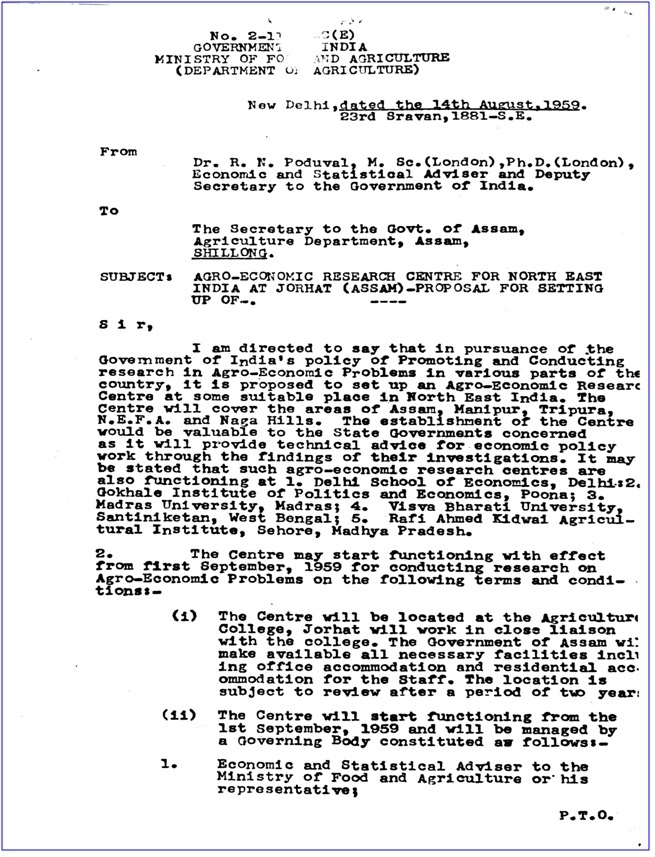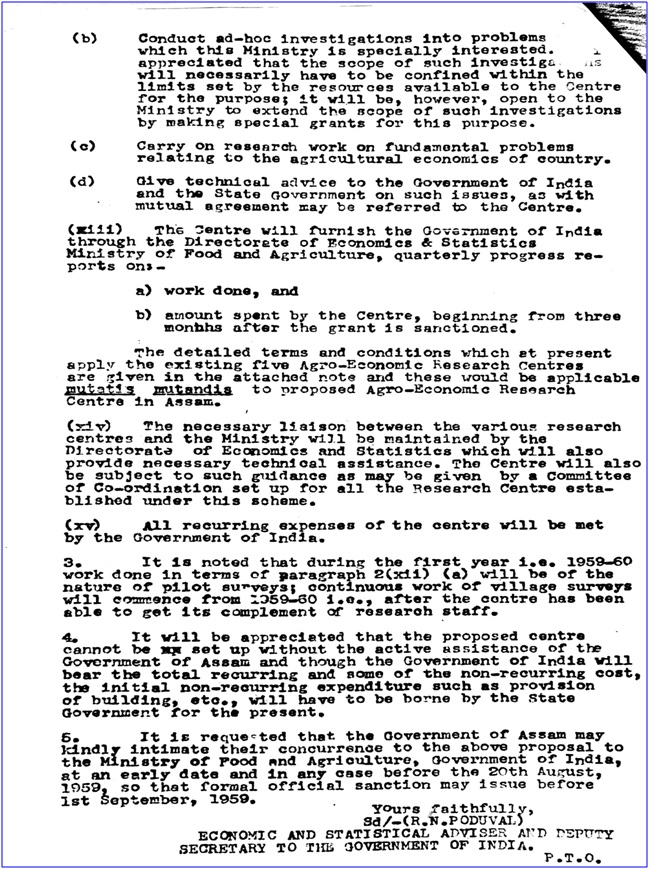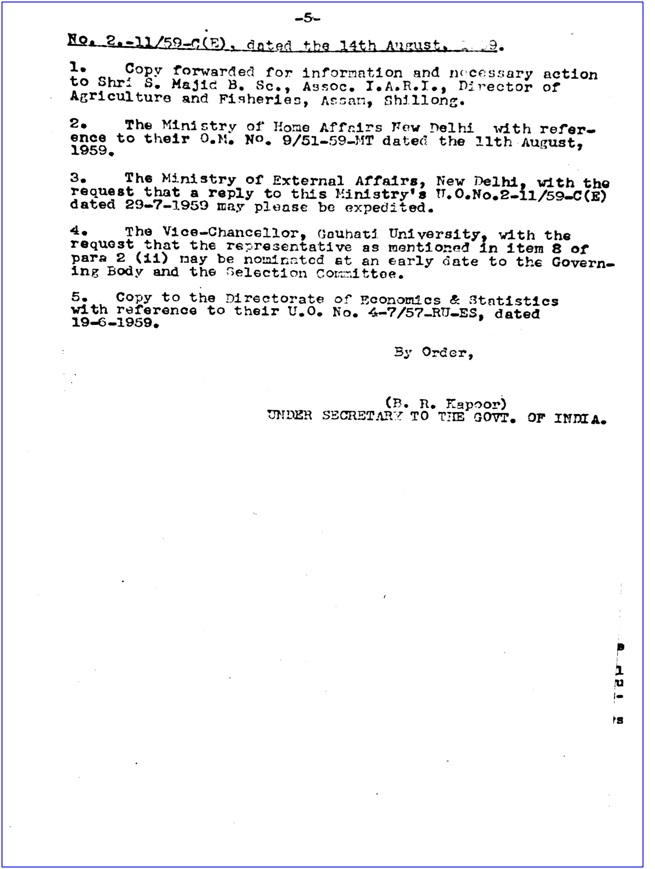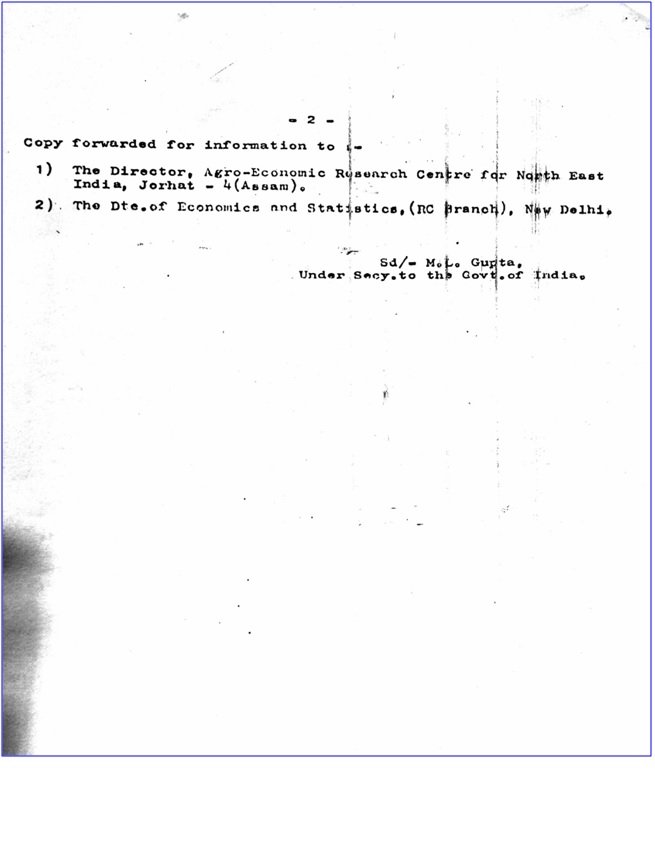

The Agro-Economic Research Centres/Units in the country are age old institutions in the field of agro-economic research in the country established by the Ministry of Food and Agriculture (Department of Agriculture), Government of India during the post independence period. The Government of India established the first Agro-economic Research Centres (AERC) in 1954atSantiniketan, Visha-Bharati University,West Bengal under the same Ministry. Presently, there are 12 AERCs and 3 AERUs in the country. These Centres conduct research and evaluation studies on the socio-economic aspects of various programmes and schemes taken up for the development of agriculture and rural economy through well-planned and significantly designed research methodologies and survey in an impartial manner to ensure freedom from official bias and also carry conviction with the public.
The Cost of Cultivation Scheme, Assam Agricultural University (AAU), Jorhat was established in 1971. Since its inception, it was attached with the AERC, Jorhat. The administration of the Cost of Cultivation Scheme, Assam Agricultural University, Jorhat was handed over to the Director of the AERC, Jorhat as Hony.Director of the Cost of Cultivation Scheme, Jorhat (copy enclosed). Since then, both the Centres are working with separate staff and separate work plan under the guidance of Ministry of Agriculture & Farmers’ Welfare, Govt. of India, New Delhi. And both the Centres are governed by the rules and regulations of the host institution i.e., Assam Agricultural University, Jorhat.
All these Research Centres/Units are supported by the Ministry with100 (hundred) percent grants-in-aids. The technical guidance of the Centresare provided by the Directorate of Economics and Statistics, Ministry of Agriculture, Government of India especially in regards to allotment of works and selection of research projects. Initially, the research projects to be taken up for a particular year are finalised in the meeting of the Officers-in-charge held annually. At present this meeting is known as Coordination Committee for Organization of Studies (CCOS). The CCOS finalized the research projects and allotted to the AER Centres and instructed to complete the studies within the specific time frame. In addition, there are few Co-ordinatingCentres who provide all the necessary guidance on different research projects including the methodologies, schedules, tabular models, etc. to the AER Centres.
The functions assigned to the Agro-Economic Research Centre are as under:
i) to make study of changes in rural economy by means of survey of a number of selected villages each year and survey of the same group of villages at an interval of, say, five years;
ii) to conduct ad-hoc investigation into problems of interest to the Ministry of Agriculture;
iii) to carry on research work on fundamental problems relating to agricultural economics of the country;
iv) to give technical advice to the Government of India and concerned State Governments on such issues as, with natural agreement, may be referred to the Centre.
The objectives remain same since inception of AER Centre, the type of research to done was guided by the needs of the Ministry from time to time. The research projects allotted in a particular year are finalised in the meeting of the CCOS held annually. Under the first objective the Centre carried on village surveys and resurveys to study the changes in the rural economy. In the later period especially after 1970, the Ministry emphasised on conducting problem-oriented studies or ad-hoc studies of short duration.
The Agro-Economic Research Centre for North-East India, Jorhat was established in 1960 in the Campus of the then Assam Agricultural College by the Ministry, Government of India with an understanding with the Department of Agriculture, Government of Assam vide letter No. 2-11/59-C (E) dated 14th August, 1959(Annexure-I), which was about 9 years ahead of the establishment of the Assam Agricultural University.
The AER Centre was first started under the administration as well as technical control of the Economic and Statistical Adviser, Ministry of Agriculture, Government of India. Later the administrative control of the Centre was handed over to the Department of Agriculture, Government of Assam. The Secretary of Agriculture, Government of Assam was the Chairman and Dr. M. C. Das, the then Principal; Assam Agriculture Collage was the Secretaryof Advisory Body. Subsequently, the administrative control of the AER Centre, Jorhat, was transferred to the Assam Agricultural University w.e.f. 1st April, 1970 vide Ministry’s letter No. 2-22/69 Econ. Py.dated the 28th May/1971(Annexure-II).
The Vice-Chancellor, Assam Agricultural University is the Chairman of Advisory Body of the Centre and the Director of the Centre is the member Secretary. Other members of the Advisory Body are Economic and Statistical Adviser or his representative, Ministry of Agriculture, Government of India.; Directors of Agriculture, Assam, Meghalaya, Tripura, Nagaland, Arunachal Pradesh, Manipur and Mizoram. The main functions of the Advisory Committee are to look after the nature and extent of work undertaken by the Centre from time to time and also other important issues relating to the Centre as may be referred to the Advisory Committee.
A letter dated 28th May 1971was issued to the then Vice Chancellor (S.R.Barooah), AAU, Jorhat for transferring of AERC, Jorhat Centre to Assam Agriculture University by the Under Secretary,(M.L. Gupta) Govt. Of India, Ministry of Agriculture, KrishiBhawan M.L. Gupta. In this letter clause 3 (iii), the Ministry categorically stated that the Ministry will provide 100% financial aid from the Ministry on annual basis and financial control with regard to sanction of posts, budget grants, etc.,will be exercised by the Ministry (Annexure-III).
AERC for NE Indiahas covered 7 (seven) North Eastern states viz.Assam, Arunachal Pradesh, Meghalaya, Manipur, Mizoram, Nagaland and Tripura respectively.
The Centre has already completed a long journey of more than 60 years of service to the nation in general and the North-Eastern Region of India in particular in the field of agricultural economy or other rural economy. Altogether, the AER Centre, Jorhat has completed183 numbers research studies on various aspects with an annual average of 3 studies till date. Since inception, the Agro-Economic Research Centre has been offering efficiently on socio-economic and evaluative research studies in the entire North-East Region as entrusted by the Ministry and providing required feed back to the Ministry of Agriculture, Government of India as well asfor different State Governments of the N. E. Region. The studies carried out by the AER Centre, Jorhat are found to be important as these have provided insights into the socio-economic characteristics of diverse communities of the entire North-East Region. The changes occurred in the socio-economic life of the villagers of NE Region due to planned efforts were highlighted in the different studies.
The village surveys or resurveys were the primary works undertaken by the AER Centres/Units including the Jorhat Centre during the first decade from its establishment. This involved survey of purposively selected villages at two points of time, usually 5 years to study changes, taking certain forces of changes for the purpose. The reports are based on complete field survey of socio-economic parameters and even socio-cultural aspects like food habits, festivals, dresses, etc. of the people. The village studies were useful sources for grass-root level information of the villages as well as different tribal and sub-tribal groups including of backward communities of the people of the entire N. E. Region. The N.E. India is the abode of a large number of tribal populations with diverse socio-economic characteristics. The village studies became a handy tool for understanding the rural economy of the Region.
The Jorhat Centre so far as completed 16numbers of first point Village Surveys and 12 numbers of Resurveys in different parts of the N.E. Region. Most of the findings of first point Village Surveys were published in the book “Rural Life in Assam Hills” and a few of findings of Village Resurveys were published in the book “Changes of Mikir Society”. It is to be noted here that there were no remarkable studies available either on agricultural economy or other rural economy of North Eastern States before establishment of AER Centre for N. E. India. Only the Department of Directorate of Economics and Statistics had conducted very limited number of studies on rural economics in limited number districts of the State.
Problem Oriented Studies
The problems oriented studies or the ad-hoc studies or evolutionary studies were under taken annually by the Centre at the instance of the Directorate of Economics and Statistics, Ministry of Agriculture, Government of India. A few of studies like Incidence of Rural Poverty in Assam, A Comprehensive Study of 20 Point Programme in Assam, An Evaluation of Sukla Irrigation Project, etc. were conducted at the request of State Government of Assam. Some studies were taken at the Centre’s own initiatives.
The problem oriented studies or ad-hoc studies or evolutionary studies completed by the AER Centre, Jorhat from its inception to September, 2015 were 145 in number. Most of the studies, by and large, were micro-level studies based on field level as well as secondary level data. Only a few of studies were based on completely secondary data which analyzed State level situations.
Preparation of separate Executive Summary on each research project was a new concept of the Ministry ofAgriculture, after 2000. Most of the Executive Summary of research project was published in the journal of “Agricultural Situation in India”. Besides, almost all the Executive Summary was published in the book “Glimpses of India”. Attention of Honourable Agriculture Minister of Assam was drawn by one recent study of the Centre, entitled “Assessment of Pre and Post-harvest Losses of Paddy and Wheat in Assam” and expressed his desire for power point presentation of the findings and suggestion of the Report. Accordingly our research staff presented the salient findings and suggestion of the Report by power point in the office chamber of the Minister on 07.10.2014. After presentation, the Agriculture Minister praised the Centre’s reports and suggested all the District Agricultural Officers to implement the important policy suggestions of the report in their respective districts.
In addition to this the Centre has a mailing list according to which the reports were circulated. It includes the Directorate of Economics and Statistics, Ministry of Agriculture, Government of India and concerned Departments who proposedstudy, members of the Advisory Body and different AER Centres/Units of the country.
The research studies are now available in the Assam Agricultural University website (www.aau.ac.in) and AERC for NE India website (www.aercnei.aau.ac.in) in PDF form. A few research reports are also uploaded in different websites of the country.
Annexure - I





Annexure - II


Annexure - III
